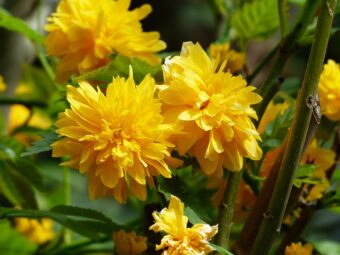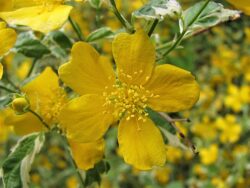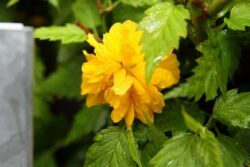In this article, we will discover how to grow the unfussy shrub of Kerria in containers. Kerria japonica is the only species of Kerria that you will find in this genus. It is actually a member of the Rosaceae (the Rose) family. In its native growing habitat, it is found in thickets on mountain slopes, making it a highly tough and adaptive plant.
There are several varieties on offer as you will discover later on. The plant gets its name from William Kerr, who introduced the cultivar ‘Pleniflora’ the most popular variety.

It is a 1 to 3m tall shrub with weak, arching stems that scrambles all over the place. The simple, alternative green leaves are 3 to 10cm long, green and doubly serrated. It loses its leaves in autumn as the shrub is deciduous. In April and May, the branches are covered with golden yellow blooms, which have five petals. The flowers are distributed evenly throughout the stems. Once the blooms have been spent, they will be replaced with a fruit that contains a 5mm large, single seed.
Find out how to grow this heavy flowering shrub in containers in this article.
GROWING KERRIA IN CONTAINERS
First, you must choose a large and tall container that has holes in the bottom of it. On top of this, add up to 5cm below the top rim with a good quality multipurpose compost. Dig a hole at the centre of the container in the compost slightly bigger than the root ball it came in its original container you purchased it in.
Drop the plant in so that the top of the root ball is at the same level as the top surface of the compost in the container. Backfill with the growing media so that there are no vacant spaces left, using more compost if you need to. Firm the plant in and water well.
THE BEST GROWING CONDITIONS
There is one plant that will do well in full sun or partial shade as it is not too fussy. Too much sunlight can cause the shrub to take on a bleached appearance and the flowers tend to fade quickly. They are easy to look after and are drought-tolerant once established. You need to water when 5cm below the top surface of the compost feels dry to the touch. When you water do so until it emerges through the drainage holes.

They are not particularly hungry plants but you can give a feed in spring with a slow-release general-purpose fertilizer at half the recommended dosage. Do not feed again during the growing season.
It is best to prune the shrub after flowering or the shrub will look leggy and unattractive. Cut it back to the desired shape and look. If the shrub has seriously become overgrown, you can prune it close to the ground. This will improve blooming and create a bushier and healthier shrub.
It does tend to sucker freely and can make it invasive (not much so in containers). To help keep it under control, you can remove all these unwanted suckers. Do not throw them away as you can use them to propagate new plants.
The other ways you can propagate it is via semi-ripe cuttings planted in 9cm pots full of seed and cuttings compost in a cold frame. The cuttings should be taken in summer.
PESTS AND DISEASES
In general, they are pests and diseases free but in 2014 it was noted that the plant was suffering from a disease. On the leaves, red spots were noted and lesions were spotted on the stems. This resulted in the shrub losing leaves and the plant will eventually die. The fungus Blumeriella Kerriae is only specific to Kerria and it has the common name of Kerria twig and leaf blight. It is believed to come from America and is a serious problem if it establishes in the UK.
VARIETIES TO GROW

The only species is Kerria japonica where the main double flowering variety is ‘Pleniflora’ which grows up to 2.5m tall. This produces golden pompon-like flowers and is borne in profusion. Best grown against a wall or on a trellis.
The normal variety is more graceful with its arching stems, full of single button-like, yellow flowers. A large flowering variety is ‘Golden Guinea’ which produces 5cm diameter blooms. Another single flowering variety is ‘Variegata’ which grows up to 1m in height and has cream-edged foliage.
CONCLUSIONS
In this article, we have discussed how to grow the beautiful flowering shrub of Kerria in containers. They are easy to care for, easy to look after and easy to propagate. They will look stunning in containers and are well worth the effort.
If you have any questions or comments that you wish to make on growing Kerria in containers, please do so in the comment box below.
Happy Kerria growing.
